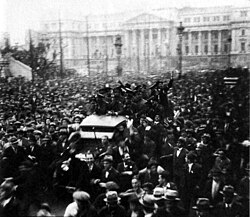| 1930 Argentine coup d'état | |||||||
|---|---|---|---|---|---|---|---|
 Crowds outside the Argentine National Congress during the coup d'etat. | |||||||
| |||||||
| Belligerents | |||||||
|
|
| ||||||
| Commanders and leaders | |||||||
|
|
| ||||||
The 1930 Argentine coup d'état also known as the September Revolution by supporters of it, involved the overthrow of the Argentine government of Hipólito Yrigoyen by forces loyal to General José Félix Uriburu. The coup took place on 6 September 1930 when Uriburu led a small detachment of troops loyal to him into the capital, experiencing no substantial opposition and taking control of the Casa Rosada.[1] Large crowds formed in Buenos Aires in support of the coup.[2] Uriburu's forces took control of the capital and arrested Radical Civic Union supporters.[3] There were no casualties in the coup.[4]
Uriburu's coup was supported by the Nacionalistas.[5] Uriburu himself was part of the Nacionalista Argentine Patriotic League and had the support of a number of Nacionalista military officers.[6] Nacionalista plans for such a coup had been developing since 1927, when politician Juan Carulla approached Uriburu for support of a coup to entrench an Argentine version of Fascist Italy's Charter of Labour.[7] With the onset of the Great Depression in 1929 that impacted Argentina, Yrigoyen lost political support as he retrenched government services which resulted in acceleration of unemployment.[8]
In the aftermath of the coup, major changes to Argentinean politics and government took place, with Uriburu banning political parties, suspending elections, and suspending the 1853 Constitution.[9] Uriburu proposed that Argentina be reorganized along corporatist and fascist lines.[10]
Future Argentinean President Juan Perón took part in the coup on the side of Uriburu.[11]
References
- ↑ Daniel K. Lewis. The history of Argentina. 2nd edition. New York, New York, USA; Hampshire, England, UK: Palgrave Macmillan, 2003. Pp. 83-84.
- ↑ Jonathan C. Brown. A Brief History of Argentina. 2nd Edition. New York, New York, USA: Facts on File, 2010 Pp. 185.
- ↑ Daniel K. Lewis. The history of Argentina. 2nd edition. New York, New York, USA; Hampshire, England, UK: Palgrave Macmillan, 2003. Pp. 83-84.
- ↑ Michael A. Burdick. For God and the fatherland: religion and politics in Argentina. Albany, New York, USA: State University of New York Press, 1995. Pp. 45.
- ↑ Daniel K. Lewis. The history of Argentina. 2nd edition. New York, New York, USA; Hampshire, England, UK: Palgrave Macmillan, 2003. Pp. 83-84.
- ↑ Michael A. Burdick. For God and the fatherland: religion and politics in Argentina. Albany, New York, USA: State University of New York Press, 1995. Pp. 45.
- ↑ David Rock. Authoritarian Argentina: The Nationalist Movement, Its History and Its Impact. Authoritarian Argentina: The Nationalist Movement, Its History and Its Impact. Berkeley, California, USA: University of California Press, 1993. Pp. 89.
- ↑ Michael A. Burdick. For God and the fatherland: religion and politics in Argentina. Albany, New York, USA: State University of New York Press, 1995. Pp. 45.
- ↑ Michael A. Burdick. For God and the fatherland: religion and politics in Argentina. Albany, New York, USA: State University of New York Press, 1995. Pp. 45.
- ↑ Michael A. Burdick. For God and the fatherland: religion and politics in Argentina. Albany, New York, USA: State University of New York Press, 1995. Pp. 45.
- ↑ Rodney P. Carlisle (general editor). The Encyclopedia of Politics: The Left and the Right, Volume 2: The Right. Thousand Oaks, California, USA; London, England, UK; New Delhi, India: Sage Publications, 2005. Pp. 525.
The original article can be found at 1930 Argentine coup d'état and the edit history here.